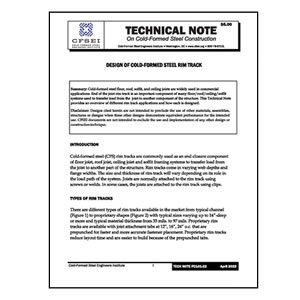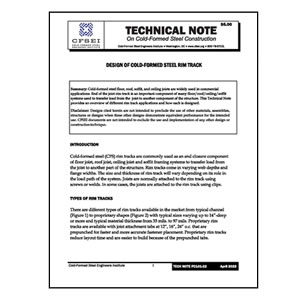Tech Note G801-13: ASTM A1003 – No Cause for Rejection
$5.00
Summary: Building codes and design standards that reference ASTM International (ASTM) A1003 standard for cold-formed steel framing products have the potential to cause confusion and project delays for those who are unfamiliar with the requirements of this new material standard. This Technical Note, first published in 2008, provides a comparison of the requirements of A1003 with the more familiar standards traditionally used for cold-formed steel framing products, and demonstrates that steel ordered or furnished to the old standards should be no cause for rejection. The 2013 revision references a change to the requirements of ASTM A1003 regarding material thickness when ordering or supplying steel sheet.
Disclaimer: Designs cited herein are not intended to preclude the use of other materials, assemblies, structures or designs when these other designs demonstrate equivalent performance for the intended use. CFSEI documents are not intended to exclude the use and implementation of any other design or construction technique.
Related Products

Tech Note S200-20: Design of Cold-Formed Steel Systems for Raised Platforms, Stages and Theater Seating
Summary: It is common for cold-formed steel (CFS) to be used in the construction of raised platforms, stages, and theater seating. It is the intent of the Technical Note to provide an overview of considerations to address when designing such framing, along with some design examples.
Disclaimer: Designs cited herein are not intended to preclude the use of other materials, assemblies, structures or designs when these other designs demonstrate equivalent performance for the intended use. CFSEI documents are not intended to exclude the use and implementation of any other design or construction technique.

Tech Note F102-21: Screw Fastener Selection For Cold-Formed Steel Frame Construction
This Technical Note updates and replaces CFSEI Tech Note F102-11
Summary: Specifying the proper fastener is necessary to assure the proper performance of the connections used in cold-formed steel construction. Cold-formed steel connections primarily utilize externally threaded fasteners, so embedment is not the controlling parameter. Instead, the design of the fastener along with the thickness of the steel govern the value of the connection. This Tech Note provides basic information for determining the appropriate screw type for various applications.
Disclaimer: Designs cited herein are not intended to preclude the use of other materials, assemblies, structures or designs when these other designs demonstrate equivalent performance for the intended use. CFSEI documents are not intended to exclude the use and implementation of any other design or construction technique.

Tech Note F101-12: Screws for Cold-Formed Steel-To-Wood and Wood-To-Cold-Formed Steel Attachments
Summary: Screws are often used to attach cold-formed steel (CFS) framing to wood members or wood structural panel decking to CFS joists or rafters. The AISI North American Specification for the Design of Cold-Formed Steel Structural Members (AISI S100) provides design equations for screw connection capacity for CFS members. The National Design Specification for Wood Construction (NDS) provides design equations for fastener/connection capacity (nails, wood screws, bolts, etc.) in wood members. The Engineered Wood Association (APA) and the building codes offer several resources for determining the capacity of screw connections attaching wood sheathing. This Tech Note reviews these resources and discusses design and detailing of these fastener connections.
Disclaimer: Designs cited herein are not intended to preclude the use of other materials, assemblies, structures or designs when these other designs demonstrate equivalent performance for the intended use. CFSEI documents are not intended to exclude the use and implementation of any other design or construction technique.

Tech Note B001-20: How Cold-Formed Steel Framing is Produced
Summary: Cold-formed steel seems like a fairly simple product when you are holding it in your hand, but as you can see, there are many production steps involving things like mining iron ore out of the ground, creating molten steel, furnaces above 2,000°F, reduction mills imparting forces in excess of 100,000 pounds per square inch, and hydrochloric acid cleaning baths before it even reaches the roll forming stage. This Tech Note has provided a basic outline of the processes involved in producing the products you work with daily, be it manufacturing, drafting, designing, engineering, installing or demolishing a building at the end of its life cycle.
Disclaimer: Designs cited herein are not intended to preclude the use of other materials, assemblies, structures or designs when these other designs demonstrate equivalent performance for the intended use. CFSEI documents are not intended to exclude the use and implementation of any other design or construction technique.

Tech Note B005-20: Introduction to Cold-Formed Steel Framing Design Aids
Summary: Both steel industry and manufacturers’ associations provide design aids that assist engineers with the proper application of the cold-formed steel design challenges. Design examples and design aids are essential to educate an engineer in the proper use and design of cold-formed steel members, connections and assemblies. This Tech Note provides an overview of some of the available cold-formed steel framing design aids.
Disclaimer: Designs cited herein are not intended to preclude the use of other materials, assemblies, structures or designs when these other designs demonstrate equivalent performance for the intended use. CFSEI documents are not intended to exclude the use and implementation of any other design or construction technique.

Tech Note W105-21: Design of Nonstructural Members
Summary: The AISI S220, North American Standard for Cold-Formed Steel Nonstructural Framing was developed in 2011 to help clearly delineate and eliminate confusion between the requirements for cold-formed steel structural members and nonstructural members. This Technical Note is intended as an introduction to this standard and as an illustrative guide for applying the provisions to the design of nonstructural members.
This Technical Note updates and replaces CFSEI Technical Note W105-13
Disclaimer: Designs cited herein are not intended to preclude the use of other materials, assemblies, structures or designs when these other designs demonstrate equivalent performance for the intended use. CFSEI documents are not intended to exclude the use and implementation of any other design or construction technique.

Tech Note B003-20: Introduction to Building Codes
Summary: The International Code Council develops a suite of building codes that are considered nationally to be the model codes for the building industry. Local jurisdictions adopt, and in some cases amend, the codes and they become the law of the jurisdiction for building design and construction. The adopted building codes are intended to provide minimum requirements to provide a safe building environment. Among other requirements, the code dictates the maximum allowable size of a building based on its intended use, materials used in construction, fire resistance rating of structural elements, and the presence of automatic sprinkler systems. The International Building Code establishes all design loads to be applied to the building or structure. The building code also relies on references to other standards and specifications to ensure the provisions reflect the current industry practice. For cold-formed steel framing, the IBC references the American Iron and Steel Institute’s suite of framing standards as the accepted design methods and procedures.
Disclaimer: Designs cited herein are not intended to preclude the use of other materials, assemblies, structures or designs when these other designs demonstrate equivalent performance for the intended use. CFSEI documents are not intended to exclude the use and implementation of any other design or construction technique.

Tech Note 551e: Design Guide: Permanent Bracing of Cold-Formed Steel Trusses
Summary: Prefabricated and site fabricated cold-formed steel trusses have proven to be efficient and structurally-sound roof structures. While roof trusses are the major component of the structural roof system, permanent bracing is also required to complete the system and ensure that it performs as designed. In this Tech Note, the basic requirements and design parameters for permanent bracing of cold-formed steel roof systems will be reviewed.
Disclaimer: Designs cited herein are not intended to preclude the use of other materials, assemblies, structures or designs when these other designs demonstrate equivalent performance for the intended use. CFSEI documents are not intended to exclude the use and implementation of any other design or construction technique.

